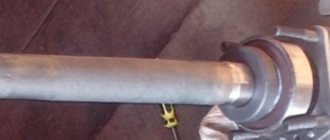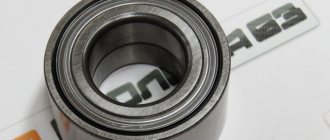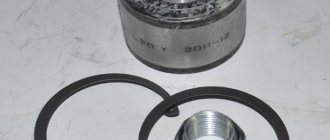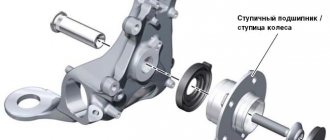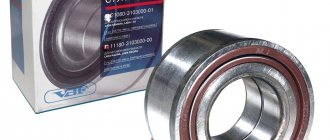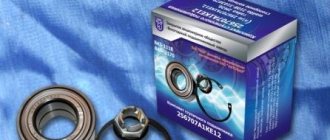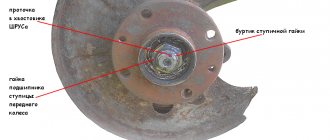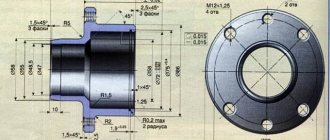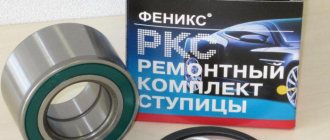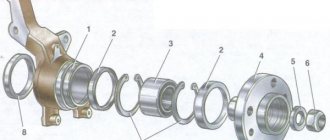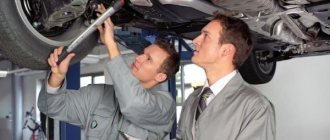If there is a constant extraneous sound (hum) from the rear wheels when driving, you should pay attention to the condition of the wheel bearing. On the VAZ 2114, this part is quite durable and it happens that the bearing travels more than 200,000 km, but if it starts to howl, its replacement is required.
In order to replace it yourself, we need the following tool:
- Vise for more convenience
- Special puller with rotating jaws
- Circlip pliers
- Wood block
- Hammer
- Ratchet and crank
- 7 and 30 mm heads
At one time I did a video review on this topic, but due to the fact that at that time I did not have all the necessary tools and a vice on hand, which are very useful when performing this repair, everything did not turn out quite as I wanted. But the essence of working in a garage environment can still be understood.
Installing the wheel bearing
Be careful! When installing a bearing, force must be applied only to its outer ring.
We take the outer ring from the old bearing and use it as a mandrel when pressing the new bearing into the hub
Using a puller, install the bearing retaining ring
Install the hub back onto the axle
- We put the thrust washer in place and lightly tighten the hub nut
- By tightening the nut, we gradually press the bearing onto the axle.
- We install the brake drum in place and screw the wheel
- Removing the jack
- We finally tighten the hub nut to a torque of 186.3–225.6 N m (19–23 kgf m) and core the edge of the nut into the groove on the axle.
- We put the cap in place.
Stages of self-repair
The entire process of self-repair can be divided into several stages, after carefully reading them, any owner will understand how to repair a car without having the skills of a professional car mechanic; it is enough to follow the following steps:
- It is necessary to drive the car into a room with a flat floor, turn it off, engage first gear in the gearbox, place a stop under the front wheels for safety, remove the rear wheel from the desired side, having first jacked up the car. It is important to take into account here that the vehicle cannot be put on the hand parking brake, otherwise it will be impossible to remove the brake drum and disassemble the rear hub assembly.
- Having removed the wheel, we proceed to unscrew the rear hub mounting nut, which tends to be very tight due to rotational axial loads, so you may need to apply the maximum possible force to break it off.
- At this stage, they begin to remove the brake drum. Using a Phillips screwdriver, unscrew the screws that secure the drum. Then carefully (using a small block), knock on the drum with a hammer from the back side over its entire surface (before dismantling, it is advisable to treat its seat with WD 40 liquid and treat it with a brush, which will significantly simplify the removal of the part).
- The next step is to remove the hub from its axis; to do this, you need to use a special puller that will carefully remove the part. Here it is worth considering that the inner race of the wheel bearing can remain on the axle, and it can be pressed out in two ways: using a wheel puller, or using a chisel and carefully knocking it down with a hammer.
- Next, we proceed to pressing the oldest bearing out of its seat in the hub, for which we remove two retaining rings, and remove it from there using a press or using a specialized puller. If you don't have a press or puller, you can use a hammer to simply knock the old bearing out of the rear suspension assembly.
- Having completely dismantled the old part, it is necessary to thoroughly clean all the seats and the axle on the axle (dirt-repellent shield of the rear brake pads) from dirt, after which everything is carefully inspected for various damages, and if any are found, the damaged unit must be replaced with a new one.
- The bearing seat is lubricated both in the hub and on its axle, then it is carefully pressed in or driven in with a hammer through a buffer (usually the old bearing race is used), the retaining rings are installed in their places, and the assembled unit is mounted on the axle, after which the locking hub nut is tightened .
- The remaining parts are assembled in the reverse order of disassembly.
Also watch the step-by-step execution of the work with the explanation of the master in the video:
Source
How to check the rear wheel bearing?
Diagnostics is similar to checking the front wheel bearing. You can do it yourself without going to a car service. There are several points by which failure is determined:
- When driving at a speed of about 50-60 km/h, noise with vibration will be heard, transferring to the car body, while the road surface will be smooth.
- Having raised one side of the car with a jack, we begin to rotate the wheel. If rotation is accompanied by extraneous sounds, this will also indicate a malfunction.
- After driving the car, touch the wheel disk at the hub. If it has a high temperature, then the part is failing.
Of course, it will not be possible to find out the critical wear of a part, but it will be possible to detect a malfunction. When a breakdown is diagnosed, it is strictly not recommended to continue driving the car; this may pose a threat to other road users.
To begin with, make sure
First, you need to determine the source of the noise - make sure that it is definitely a wheel bearing. The car is driven onto a lift or placed on jacks, the wheels are hung and spun manually or using an engine. In this case, the “suspect” wheel is listened to during free rotation, that is, the gearbox is switched to “neutral” or the clutch is depressed.
The bearing is also checked for play: the suspended wheel sways in a vertical plane (up and down, away from itself). Here it is important to make sure that the detected play is caused by the bearing and not other parts of the chassis. By the way, such a check will not be superfluous during every vehicle maintenance, even if the bearings do not emit characteristic noise while driving.
Necessary tool
Before starting work on replacing the rear wheel bearings on a VAZ 2114, we need to collect the necessary tools according to the list:
It is better to have a can of WD-40 or liquid wrench, as the parts are susceptible to corrosion and can be difficult to unscrew. If possible, you can purchase or find a special puller for the hub, which will make the work a little easier.
List of required spare parts and tools
The domestic spare parts market offers a wide range of parts for replacing the rear wheel bearing on a VAZ 2115 and similar models, but when choosing, you should pay attention to those that have the approval of the automaker, thereby confirming their quality, namely:
Carry out the work of replacing the rear wheel bearing on a VAZ 2115 quickly, reliably and without damaging other suspension components, possibly using the following tools:
- open-end wrenches (available in sets from 8 to 21 mm);
- socket heads (set from 8 to 24 mm);
- car jack;
- 30 mm socket head and extended knob;
- torque wrench;
- thin round nose pliers for removing retaining rings;
- specialized bearing presser;
- specialized hub puller;
- hammer;
- Screwdriver Set;
- bottle WD 40;
- brush;
- gloves for hand safety.
The cost of fixing this problem at the sites of official dealers ranges from 3,500 to 4,000 rubles (at the end of 2022), small private garage-type workshops estimate it from 2,000 to 3,000 rubles. The presence of the above-mentioned parts and tools, as well as simple car mechanic skills, will allow the owner to carry out repairs with his own hands without much difficulty.
Symptoms of malfunction
The first symptom of a malfunction will be a noise heard from the rear of the car. This means that the mechanism runs out of lubricant and the metal parts begin to rub against each other. The next thing that will happen is that vibration will be added to the body, which will be caused by slight wear of the element. When a part is on the verge of failure, an unpleasant smell will be felt, as if the brake pads are stuck in the drum. It is better not to let this happen, as the wheel begins to jam and the bearing can fall apart at any moment.
When Replacement May Be Required
If you hear a noise, a characteristic noise or a certain hum in the rear of your car, which only intensifies when entering a turn, this indicates an urgent need to replace the rear wheel bearing on your VAZ 2110.
Hub device
There are several ways to check the state of an element:
- Lock the wheel in a diagonal plane. Raise the rear wheels one at a time using a jack.
- It is recommended to lift them one at a time in order to correctly determine the source of the noise. It is not always necessary to replace two bearings at once. But if you take on one, replace the second one immediately. Fewer problems will arise in the future.
- Spin the wheel raised on the jack by hand, as hard as you can. The higher the speed, the better. If extraneous noise or humming noises are detected when the wheel spins, the part will definitely have to be replaced.
- If there is any doubt about the integrity of the rear wheel bearing, use the lateral play method. Grab the wheel by its edges and pull it towards you and away from you. If the bearing actually fails, the wheel will move along the axle. The movement may not be strong, but even slight fluctuations indicate the need to replace the element.
Replacing the rear wheel bearing
When starting to replace the rear wheel bearing of a VAZ 2114, place the car on a level surface and place supports under the wheels for safety. Then you can begin the replacement process:
- Remove the plug from the wheel that covers the hub nut. We unpin it using a core and a hammer.
- We loosen it using a wrench and a 30mm socket. First, you can spray a special agent on the threads that will corrode the rust. Also, the handle of the wrench can be extended using a piece of pipe, which will increase the leverage and provide a smooth load on the nut.
- Raise the car with a jack and remove the wheel.
- Check that the car is not on the handbrake! Unscrew the drum mounts. The adjacent holes have threads. We screw the bolts in there, which will allow the part to be pressed out. You can also tap the drum in a circle using a hammer and a block if it is very difficult to remove.
- Unscrew the bearing nut completely.
- You can remove the hub using the drum and engine head bolts. We screw the drum on with the back side and pull it towards ourselves, so the hub will come out. You can try to knock it out with a hammer or squeeze it out using a pry bar.
- Now we need to pull out the wheel bearing itself. It is best to use a special puller for this. When you don’t have a puller, you can use a grinder to slightly saw down the old element and knock it down.
- Remove the retaining ring in the hub using pliers.
- Next we need to press out the old bearing; if there is no puller, we can try to knock it out. If you can’t remove it, then you can contact a service center that has a hydraulic press, and they will also install a new part for you.
- After installing the new bearing, do not forget to install the retaining ring. Now lubricate the installation site with oil and install the part in place.
Further assembly occurs in reverse order. Be sure to check the tightness of all bolts after installation. Also be sure to tighten the bearing nut.
Rear suspension and chassis design
Bearing produced by AvtoVAZ
Before proceeding directly to the replacement process, it is worth considering the rear suspension structure in order to understand the location of the part, as well as determine what needs to be removed in order to change the rear wheel bearing.
Sectional view of the rear chassis
1. Rear wheel hub; 2. Rear suspension arm; 3. Suspension arm mounting bracket; 4. Rubber bushing for the lever hinge; 5. Lever joint spacer; 6. Rear suspension arm mounting bolt; 7. Body bracket; 8. Support washer for fastening the shock absorber rod; 9. Upper suspension spring support; 10. Spacer sleeve; 11. Suspension spring insulating gasket; 12. Rear suspension spring; 13. Shock absorber rod mounting pads; 14. Compression stroke buffer; 15. Shock absorber rod; 16. Shock absorber protective cover; 17. Lower support cup of the suspension spring; 18. Shock absorber; 19. Lever connector; 20. Hub axle: 21. Cap; 22. Wheel hub nut; 23. O-ring; 24. Bearing washer; 25. Wheel bearing; 26. Brake shield; 27. Retaining ring; 28. Mud deflector; 29. Suspension arm flange; 30. Shock absorber bushing; 31. Lever bracket with eye for mounting the shock absorber; 32. Rubber-metal hinge of the suspension arm;
Price and article number of the rear wheel bearing for VAZ 2114
Many car enthusiasts, when choosing a new part, prefer original spare parts. They have a price above the market average, but differ in the quality of the product. In stores you should look for them exclusively by article numbers 2108-3104020 and 2108-3104020-02 .
It is under them that parts from the AvtoVAZ plant are produced. When the part numbers are not indicated or have a different meaning, it may be a Chinese counterfeit made to match the original packaging, also pay attention to this when purchasing!
The average cost of an original bearing is about 1,500 thousand rubles .
Replacement procedure
Lubricate
So, we have determined that there is no way around this, and the car really needs to replace the bearing. Therefore, we adhere to a clear procedure and begin work.
- Remove the brake drum. There should be no problems with this, since it is fixed quite simply on the rear wheel.
- Pry up the hub cap using a flathead screwdriver and remove it.
- Now, using a narrow chisel, straighten the collar of the nut, which was jammed in two places at once. Don’t be afraid, it wasn’t you who did something, such a jam is provided at production so that the element does not fly out of its rightful place.
- Use a 30mm socket to unscrew the fastening nut.
- Remove the unscrewed nut and also dismantle the thrust washer.
- Arm yourself with a three-legged or two-legged puller, which will allow you to remove the hub from its place.
- If you don't have a three-jaw tool, press out the hub using two bolts or screws. As the practice of craftsmen has shown, bolts for fastening the head of a power unit are excellent for these purposes.
- Screw the screws into the opposite holes for fastening the wheel and rest their ends against the heads of the bolts securing the hub axle to the rear suspension beam of your car.
- Try to tighten the screws evenly to allow the hub to press out. There is no need to remove the pads.
- As a rule, the inner race of the bearing should remain on the hub axis.
- Secure the ring using a puller, then remove it.
- If you don’t have a puller, you will have to additionally dismantle the brake pads and use a chisel to mix the ring to the axle.
- Next, the ring moves. Two mounting blades will help you with this.
- Do not be afraid that after processing with a chisel, some kind of defects or nicks will form on the hub axis. This is not terrible, but it is highly recommended to process them with a needle file.
- Arm yourself with pliers, thanks to which you can carefully remove the retaining ring.
- Using a piece of suitable pipe, also carefully knock out the bearing, leaning on the inner ring.
- Another option is to press it out using a wheel bearing puller.
- Clean and effectively lubricate the hub into which the new rear wheel bearing is pressed with a puller or vice. The pressing force must be applied to the outer ring. It will be most convenient for you to do this using the outer ring from an old bearing.
- Install the new retaining ring in its proper place.
- Using light blows on the inner ring, press the bearing onto the axle. Drive until deep enough to fit the nut.
- Full pressing is carried out with the nut already on.
- Be sure to use only the specified torque to tighten the fastener.
- Press the collar of the nut into the two grooves of your hub axle to restore the element to its original appearance.
This procedure cannot be called incredibly complicated, but you will have to “tinker” in your garage. But this is better and more cost-effective than going to a service station and entrusting your car to unknown specialists.
Good analogues
You can also opt for analogues that have excellent reviews from car enthusiasts:
- Part number R172.04. The average price on the market is about 1,500 rubles .
- GKN-Spidan. Catalog number 26727. The cost is also about 1500 rubles .
- Search number H10 1206. The average price on the market is about 1200 rubles .
The quality of these brands is not inferior to the original and in some cases they last even a little longer than the original. Of course, the service life depends on driving style, so there is no exact data on the mileage of the bearings. Replacing a wheel bearing with your own hands is not a labor-intensive process that can be done without going to a car service center. The average price for such a procedure starts from 1000 rubles, which means that by doing car repairs yourself, you can save a third of your budget. You can extend the life of the bearing by not using the car in difficult conditions and on poor roads unnecessarily. This will help reduce the load on the chassis, which in turn will reduce wear.
Don't delay
On older cars, wheel bearings were inexpensive and lasted a long time, and the resulting play was subject to adjustment for the time being. On the other hand, “tightening” the unit was also a simple matter... In modern models, the bearings are no longer adjustable, often come assembled with the hub, and accordingly they are not cheap. What’s even worse is that their service life often does not exceed 100 thousand km. Why?
In addition to natural wear and tear, a wheel bearing can fail prematurely due to exposure to water and dirt due to insufficient protection or its violation. On some models, bearings are almost “consumables” for precisely this reason. Also, premature “death” is facilitated by shock loads that occur when a wheel falls into a hole or when it hits a protruding bump, hatch or curb at speed. This is especially true if the car is equipped with wheels with low-profile tires, whose shock-absorbing qualities are minimized, so every impact is transferred to the chassis.
Unlike some other components, the wheel bearing “informs” in advance with increased noise about its wear and allows the owner to slowly think about repairs and get to the service center. But you shouldn’t abuse his “patience”. Yes, as a rule, the wear progresses, the noise increases, but the unit can travel for several thousand kilometers. But sudden destruction also happens, and depending on your luck. At best, you simply won't be able to drive any further with a dangling wheel. At worst, if the bearing jams while driving, this can lead to an emergency or damage to other parts of the chassis. Do you need it?
Replacing the rear wheel bearing of a VAZ 2114
Changing the rear wheel bearing is very difficult, but it is still possible to do it yourself, just like replacing the front wheel bearing. The driver will need to become familiar with the design features of the car and have basic skills in suspension repair, but any motorist who reads these instructions can handle it. In the material you will learn step-by-step instructions, the necessary tools, the causes and consequences of a rear wheel bearing failure on a VAZ 2114, and of course, any nuances of repair and replacement of parts.
What will you need for replacement?
The easiest thing to change is usually the rear wheel bearing. To replace it in most cases you will need the following tool:
- jack;
- wheel wrench;
- wheel chocks;
- pliers or round nose pliers for removing the locking pin;
- a flat-head screwdriver, hexagon or asterisk for unscrewing the brake drum stopper (a key if discs are installed at the rear);
- wrench for unscrewing the hub nut;
- bearing puller;
- bearing and lubrication.
It is recommended to stock up on lubricant if you purchased a bearing from an inexpensive price segment. As practice has shown, the manufacturer often supplies an insufficient amount of lubricant with cheap bearings.
Before replacing the front bearing, find information about exactly how the hub is designed. In some cars, the bearing is rolled into the hub and cannot be replaced separately from it. This design simplifies the replacement procedure and eliminates a number of errors, but the spare part itself in this case will be more expensive.
To replace the front wheel bearing, depending on whether you have a multi-link or MacPherson strut suspension, you will need several sockets and wrenches. In this case, the easiest way is to prepare a standard set of tools.
In the vast majority of cases, the rear wheel bearing is easier to change. And the set of tools that are described for replacing the front bearing will be sufficient for working with the rear hub.
Additionally, to replace the front wheel bearing, it is advisable to acquire:
- penetrating liquid WD-40 or equivalent;
- with a short chisel (to wedge the ball joint mounting lever if you cannot remove the pin from the eye).
How can you tell if a bearing is broken?
As practice shows and manufacturers claim, replacement must be carried out every 100,000 km. car mileage, but this can be influenced by many circumstances. For example, weather conditions, damage, road quality.
The first sign of a rear wheel bearing failure will be noise or hum in the wheels, which will turn into vibration. A grinding noise or increased play in the chassis may also indicate a malfunction.
To prevent replacement of the rear wheel bearing, diagnostics are required approximately every 2000 km. mileage And so, to check the bearing, you need to rotate the chassis “in weight” and if there are strange sounds or braking of the wheel, the bearing should be replaced. It is also worth checking the wheel play by manually moving it along the axis, but even if there is no noticeable play, this does not mean that the bearing is intact and in working order.
It is recommended to follow the first verification rule. But to be completely sure of a breakdown, you will need to unscrew the bolts and see how the brake disc rotates. If the VAZ 2114 bearing is in working condition, then nothing interferes or makes noise when rotating.
Rear hub device for VAZ 2114
Before replacing a broken part, it is advisable to familiarize yourself with how the rear hub in a VAZ 2114 car works.
Rear hub device for VAZ 2114
- Rear axle shaft;
- Dirt ring;
- Retaining ring;
- Wheel bearing;
- Rear hub;
- Washer;
- Hub nut;
- Pad;
- Protective cap.
MrPodshipnik
Bearing replacement, repair
Enter the marking or size (for example: 8*22*7) of the product and the country of sale
- Car brands
- Auto components
- Moto
- Velo
- Equipment
- Tool
- Technique
New instructions
- How to make your own repairs and replace the bearing on the steering column in a ZOOM bicycle 10/09/2019
- How to independently, at home, replace a bearing in an electric motor of a Philips food processor 10/05/2019
- We repair a DAB heating circulation pump and change the bearing ourselves 10/04/2019
- How to repair a Shimano fishing reel yourself and replace a faulty bearing 10/03/2019
- We replace the bearing and repair the SBR_ 132_A concrete mixer ourselves 10/02/2019
Guide for replacing the rear wheel bearing of a VAZ 2114 on your own
This article will tell you, point by point and in all details, how to diagnose a breakdown and how to replace the bearing of your VAZ 2114 car.
I will advise and give recommendations on how to do the repairs yourself. Listen to my opinion on how to choose a new quality part.
- How to make a diagnosis yourself
- How to find out that the breakdown is in this particular unit
- Your actions before replacing the bearing on the fourteenth VAZ model
- How to remove the rear wheel bearing when repairing a VAZ 2114
- How to install a rear wheel bearing on a VAZ 2114
- Choosing a new bearing for VAZ 2114
- Some practical advice from the master
- Video: the simplest and easiest way to replace the rear wheel bearing on a VAZ 2114
- Photos on the topic
How to make a diagnosis yourself
If your VAZ car belongs to models such as 2110,2111,2114 and others, then after a mileage of 90,000 km the rear wheel bearing needs to be replaced. The cause of damage, as a rule, is its long-term use, environmental exposure, humidity, radial and axial load, and, alas, the quality of our roads. Evidence of a breakdown is a hum that you hear even when driving on a high-quality road.
Replacing such a VAZ part is quite easy. Following my advice, you will do it yourself without effort and problems. Since, in my opinion, the bearing design of the so-called fourteen is quite simple. In this regard, removing the old worn bearing and installing a new one is not difficult. I will help you with consultation and advice.
The issue of replacing the bearing is not too serious, but I would strongly advise you not to delay the repair. This is quite simple to do; you can do it without complex and expensive tools.
How to find out that the breakdown is in this particular unit
To begin replacing either the rear or front bearing, you must finally make sure that the failure is here.
- You have traveled a long way and hear a noise in the wheel. And then comes a strong vibration. Touch it. If it is very hot, then bearing replacement is necessary;
- When a strong grinding noise is heard, this means that the cage and separator can no longer be helped;
- you have discovered an increase in chassis play - the locknut has not been tightened or the bearing is broken;
- When lifting the car, try to unscrew the wheel bolt. If you pump the wheel too much and the noise is weak, your assistant presses the brake, and you do it all again. Is there any noise now? We will change the bearing together.
To finally make sure that the bearing is broken, I will tell you one more check. If the locknut is tightly tightened, and now the play and all sorts of noise disappear, this spare part will serve you for some time.
Your actions before replacing the bearing on the fourteenth VAZ model
You should know how the rear hub of the VAZ 2114 works. Look at our photo and familiarize yourself.
Let's get ready for repairs. You need to place the car on a flat surface. This will make it more convenient to replace the part. Good light at the repair site is very important.
I will tell you your steps in preparing to repair the damaged part.
- put the car in first gear;
- you need to put a stop against the car rolling away;
- Be sure to turn off the hand and pedal brakes, since when you disassemble the unit being repaired, you need to eliminate interference from the pads.
You will need the most common tools for repairs, the same ones that any car enthusiast has in his garage. You will need to use a jack, a vice, and a puller that has flat jaws. The use of round nose pliers will come in handy and various locksmith wrenches will also not interfere with the work.
How to remove the rear wheel bearing when repairing a VAZ 2114
1.Wheel bolts need to be loosened. We do the same with the hub locknut.
2.Next, use a jack and raise your car. After the nut is loosened, unscrew it completely and now you need to remove the wheel. And immediately the drum mount must also be removed.
3.Now remove the drum. It would be good to try to shake it up quite strongly before doing this.
4.Failed to do it? I advise you to use a lubricant to treat the joints.
Another practical recommendation for you. Naturally, the drum was not removed for a very long time, so dismantling does not seem easy. To make this task easier, do this. The studs must be tightened and screwed into the hole gradually, one after the other. A hammer will help you with this.
5.Now the hub and locknut are available to us. We can take further actions. This is the extension of the stopper; you also need to unscrew it. To make this procedure easier, applying an extension to the pipe is very useful.
6. Now we need to press out the hub. Using a puller will greatly help in this process. Grab a place behind the hub, the blow is made from the end. When you tighten the removable device, this part is easily dismantled. If you don’t have such a tool in your garage, I’ll tell you how to do without it. You will need a metal pipe with a diameter that is slightly smaller than the diameter in the bearing.
7.Some parts remain in the middle of this connection. This is a separator, rollers, with an internal race. There are times when it is also necessary to replace the pads. Then you must unscrew the axle mount. Do you need to replace the pads? Great, let's move on to number 10.
8. We dismantle the product by unscrewing the bolts. Let me remind you that we are removing the brake flap and pads, as well as the axle. We use a hammer and hit the hub nut. A very important point! I advise you to do this extremely carefully so as not to damage the axle shaft.
9.The brake flap is removed simultaneously with the axle. The part at the back often burns. You have to tap it to remove it.
10.The axle has a seating surface; the holder is removed from it. Use a puller.
11. Let's deal with the hub itself now. You need to place it on two surfaces, as in the photo.
Using a head that fits the inner diameter of the holder, the car part is knocked out with a hammer. Congratulations! Together we finished removing the wheel bearing.
How to install a rear wheel bearing on a VAZ 2114
- The very first thing, of course, is to clean all parts from dirt. The hub and axle shaft are cleaned with gasoline. We apply lubricants and coat all repair parts;
- The ball bearing is now installed on the hub. Do this with extreme precision;
- press the part with your hand and insert it into the hole. It will be useful to use an old bearing; it is installed on top of this structure.
- without allowing any distortion, use a hammer (it is more convenient to use the side part) to hammer the new part inside;
- at this stage it is already possible to install a retaining ring using pliers;
- We put the assembled parts on the axle, then the washer, and at the end the hub locknut is screwed in. Using it, the hub is pressed onto the axle and we make sure to lock it.
- final stage. The drum is installed, the chassis is strengthened and screwed on.
Together we did a great job with the renovation!
Choosing a new bearing for VAZ 2114
Since the VAZ 2114 uses an angular contact double-row ball bearing, I would recommend this choice from the manufacturers of these spare parts. Manufacturers from Russia have proven themselves excellent in this area.
I mean the Russian brand SPZ and VBF. Among foreign brands, I recommend purchasing bearings from Germany (FAG brand) and Sweden (SKF). Take my advice - do not buy parts from unknown companies. Although they are cheaper, the quality leaves much to be desired.
Some practical advice from the master
1. Buy spare parts only from reliable stores. If you go directly to the manufacturer, this will be an ideal option.
2. I recommend changing these parts on both sides at once, because wear occurs simultaneously.
3.Repairing and replacing the wheel bearing will still take some time. Set aside one day for this. And reach out with any questions. I'll help you, I'll give you some advice.
Video: the simplest and easiest way to replace the rear wheel bearing on a VAZ 2114
Tools needed to replace rear wheel bearing
If a breakdown or malfunction is still found, then you can read the step-by-step instructions for replacing the rear wheel bearing on a VAZ 2114.
First you need to find all the tools necessary for the work, this list includes:
- various wrenches (open-end and spanner),
- rags
- vice,
- socket wrench No. 30 or wrench,
- round pliers,
- wheel wrench,
- jack,
- socket wrench No. 12 and hammer.
Of course, if possible, it is advisable to purchase a universal puller for flat-foot bearings. Not only will you need it now, but it will also come in handy for replacing the front bearing.
Step-by-step instruction
1. Using a flat-head screwdriver, remove the hub nut cap.
2. Loosen the hub nut using a 30mm socket. The nut is tightened with great force, so you can put a pipe on the knob to pull through a larger lever.
3. Loosen the wheel bolts and jack up the car.
4. Completely unscrew the wheel bolts and remove the wheel.
5. Now you need to remove the brake drum. To do this, unscrew the drum studs using a seven-deep socket. Next, screw the drum studs into the other holes only. This should be done evenly, twisting each pin a little. As you twist, you will see the drum move away.
After the studs have been completely screwed in, unscrew them and remove the drum by hand. If it doesn’t work, you can hit it with a mallet from the back side.
If it is difficult for anyone to imagine how to do this, watch the video.
6. After removing the drum, completely unscrew the hub nut and remove the washer.
7. We put on the puller and pull the hub off the shaft. She doesn't sit very well.
8. Remove the bearing retaining ring.
9. Remove the ring on the hub. We clamp the hub in a vice and knock it down with a blunt chisel.
The ring must be removed for subsequent pressing of the bearing.
10. We select the head according to the size of the bearing, put it in the hub, clamp everything in a vice and squeeze the bearing out. He will reach the jaw of the vice and rest against it. We install spacers, for example, as in the photo below and press them out completely.
11. Clean the bearing seat from dirt and rust.
12. Lubricate the bearing seat with oil.
13. Place the bearing in the hub, clamp it in a vice and press it flush with the hub. Make sure that at the beginning the bearing moves without distortion.
Next, we substitute the old bearing as a cage and press it in until it stops.
14. Install the retaining ring.
15. Install the ring. We hit it through the spacer with a hammer so that it sits in its place.
16. We put the hub on the shaft and attach the hub nut.
17. Tighten the hub nut with a torque of 185–225 Nm. If there is no torque wrench, then tighten it with a 1 meter lever with a force 2 times greater than the tightening of the wheel bolts.
Make sure that the car does not fall off the jack; it is better to place a stop.
18. After tightening the nut, tighten it so that it does not unscrew.
19. Next we do the assembly in reverse order:
- install the drum
- install the wheel
- cap the nut
The work takes about an hour.
Video lesson
You will need: a thin chisel, a socket wrench 30, a puller for retaining rings, a press or puller to press out the bearing, a universal puller.
A 2-row ball bearing 2 is installed in the hub, which does not require adjustment or lubrication during use. If the swinging of the suspended wheel causes play, or there is noise while driving, the bearing from the hub may be faulty.
Hub from the rear wheel: 1 - mud ring, 2 - bearing from the hub, 3 - hub, 4 - thrust washer, 5 - nut for fastening the hub, 6 - o-ring, 7 - hub cap, 8 - retaining ring, 9 - axle from the hub.
Helpful advice
To press the bearing, you need to use the appropriate size mandrels from the kit. If there are no mandrels, you can use rings from an old bearing.
1. Engage first gear and place chocks under the front wheels.
2. Remove the protective cap and unlock nut 5 from the hub fastening.
3. Loosen the bolts for securing the wheel and the nut from the hub. The hub nut is tightened with a large torque, so it is better to select a lever such as, for example, a piece of pipe.
4. Raise the rear of the machine and place it on secure supports.
5. Remove the necessary wheel and brake drum (see the article on how to remove and install the brake drum).
6. Completely unscrew the nut from the hub and remove the thrust washer.
7. Install the puller and press the hub off the axle (to make the puller easy to install, it may be necessary to remove the brake pads).
8. Clamp the hub in a vice and remove the retaining ring from it
9. Press the bearing out of the hub and clean the internal cavity in the hub. Press in the new bearing and install the retaining ring.
Warning
You need to make sure that the retaining ring fits completely into the groove of the hub.
10. Press the hub onto the axle using a suitable mandrel by applying force to the inner ring in the bearing. After this, you need to install the pads, brake drum and wheel.
Note
Before installing the brake drum, it is necessary to thoroughly clean the mating surfaces of the drum and hub from scale and rust, because even the smallest particles sandwiched between these surfaces can cause drum beating and vibration during braking.
11. Finally tighten the hub nut and bolts to secure the wheel to the machine standing on the ground.
Warning
Only use a new hub nut.
You can use nuts from other wheels (so that the jammed and old parts of the shoulder of nut A do not fall into the grooves B of the axle during the punching process).
12. After fully tightening the nut from the hub, lock it and install the protective cap.
Replacing a wheel bearing is a moderately complex and labor-intensive repair operation. Most car owners carry out this procedure at a car service center. For those who do not want or cannot use the services of a car service, we will tell you how to change the wheel bearing yourself and shed light on some of the intricacies of this work.
How and which bearing to choose?
Choosing a new part is often quite difficult, because there are many nuances that play a big role. When choosing a new bearing, you should always pay attention to the quality of the product, technical specifications, certificate and packaging confirming originality. But in addition to the original VAZ2114 rear wheel bearing, there are many replacements that are also available and recommended for purchase. We advise you to familiarize yourself with all existing options for replacing a faulty part.
Original part
2108-3104020 and 2108-3104020-02 are the original numbers of the rear wheel bearing for the VAZ2114. This car part with this number is made at AvtoVAZ factories. It fits the seat exactly and its approximate price is 2000 rubles.
Analogue parts options
In addition to the original bearing models, there are many other equally high-quality options that are also suitable for installation. And these are the options that most drivers of VAZ 2114 cars choose, since sometimes the quality and service life of these parts exceeds even the original bearings. But it is not recommended to buy bearings from an unknown manufacturer.
Some nuances and recommendations for selecting, purchasing and installing a rear wheel bearing:
- You should only buy bearings in original stores or order from factories!
- Change parts on both sides, because they have the same service life.
Source
Replacement nuances
We have already said that in modern models, wheel bearings can be assembled with the hub, which affects the overall cost of the unit. On the other hand, an aggregate replacement has its advantage: in theory, the work is simpler and costs less, and it is also more difficult for the contractor to “mess up” during the installation/dismantling process. Although even here there may be nuances.
If the bearing is replaced separately from the hub, this usually means more work, and possibly the use of additional equipment. For example, you still have to remove the hub, press out the old bearing, press in a new one, and put the entire assembly in place. And here there are more than enough opportunities for force majeure: on the drive wheels, removing the hub from the drive shaft may be a problem; if we are talking about the front wheels, then you may have to remove the steering knuckle, which means additional operations to disconnect the ball joint, steering rods, etc.
In addition, in some models, replacing a bearing entails additional operations and losses. For example, the unit cannot be dismantled without removing the ABS sensor, but it becomes so “rooted” that you have to literally pick it out and then install a new one. And this increases the cost of all repairs.
Again, to dismantle/install the bearing itself, it is necessary to use a special tool (press, mandrel), because hammering it with a hammer can damage both the seats and the new bearing itself. And if you have a “rarity” with adjustable bearings, then the task here is not to “overpress” or “underpress” them, otherwise the new parts will not last long.
In other words, the procedure for replacing wheel bearings has its own nuances and requires at least accuracy and an understanding of technology. Otherwise, instead of solving the problem, you may get it repeated, or even worsened. So entrust this operation to those you can trust. If you can’t, do it yourself, but wisely.
The same goes for spare parts. When the cost of the “original” or a high-quality substitute exceeds $100, there is a great temptation to take a simpler “license”. At a minimum, you should explore the issue and ask yourself up to what point saving makes sense. Indeed, in the case of wheel bearings, buying inexpensive parts of questionable quality rarely ends in a happy ending. Therefore, we “smoke” owner forums or consult with craftsmen/sellers - and find an option that will definitely not be scrapped after a couple of thousand kilometers.
Thinking about how to save money on repairs? There are more than 82 thousand offers for spare parts in our advertisement database.
Hub functions
The main part of the car chassis assembly that experiences the heaviest loads is the hub, both front and rear. Because it is an intermediate part connecting the wheels and suspension of the car. If this important part breaks down, there is a threat to all road users. Each wheel has its own hub. The wheel is rigidly attached to the hub and performs a rotational movement around its axis, and the hub is attached rigidly to the car’s suspension. Depending on what kind of drive the car has, the functions of the hub differ. If the car has rear driving wheels, then the rear wheel hubs perform an additional function - this is the redistribution of torque from the crankshaft to the wheel. It turns out that the rear hub of such cars is an element of the transmission, and not just the chassis. The following parts are attached to the wheel hub - brake discs or drums. Inexpensive machines have drums installed. Therefore, another function of the rear wheel hub is to provide braking. In addition, the hub serves as a location for installing various sensors (speed, ABS, control and other technical indicators) that modern cars are equipped with. These are the functions of the rear hub:
- Ensuring rigid, reliable fixation of the wheel to the suspension.
- Ensuring the wheel rotates around its axis.
- Maintains anti-lock braking and braking systems.
- Serves as a mounting location for various sensors.
Selection of ZPS
When choosing a rear wheel bearing, you should focus on the required characteristics and manufacturers who today produce ZPS suitable for the VAZ 2109.
Let's start with the characteristics. The choice should be made in favor of bearings with the following parameters.
For the rear hub, a ball, angular contact, double-row closed type bearing is used.
Now let's talk about manufacturers. There are several of them, each of which has its own characteristics.
Replacement
Since the test results showed that the old rear wheel bearing has already served its purpose, it will need to be replaced.
Replacement procedure
Many people ignore the noise and hum of the ZPS until a certain time. But if timely repairs are not done, this can lead to serious problems that can result in the following consequences:
- Initially, hum and noise will cause discomfort due to their unpleasant sounds. Many motorists are accustomed to comfort, so they will do everything to get rid of the noise;
- If you continue to ignore the problem bearing, you will soon have to replace not only it, but the entire rear strut. And these are serious financial losses;
- Bearing wear leads to disruption of the running system. From here, the car can behave in the most unpredictable ways, increasing the likelihood of an accident.
Don’t joke with a problematic air conditioning system, but it is better to start repairing it immediately when you notice signs of its malfunction.
- After checking, lower the car to the ground, loosen the hub nut and bolts holding the wheels.
- Remove the decorative cap from the hub nut, then unlock the nut, loosen the tightening and use a socket with a lever to increase the force, remove the fasteners. Please note that these nuts are tightened with a large torque, so you will have to work hard.
- Loosen the tension on the wheel bolts.
- Use a jack to lift the side on which you will begin the repair. In this case, the car must be in the first gear position at the gearbox.
- Remove the wheel.
- Remove the brake pads and drums, which will allow you to completely unscrew the hub nut and put it aside along with the thrust washer.
- Now you have got rid of everything unnecessary, so you can arm yourself with a special puller to press the hub off the axle.
Removing an element
You will need a vise to hold the removed hub. Without them, removing the bearing will be quite problematic.
Don't forget to remove the retaining ring before doing this.
Using a mandrel and puller, press out the old bearing.
It is extremely important to treat the hub, wash it, removing all dirt. Only after the hub has been cleaned can a new bearing be pressed in that meets the parameters required by the VAZ 2109. Only after the hub has been cleaned can a new bearing be pressed in that meets the parameters required by VAZ 2109
Only after the hub has been cleaned can a new bearing be pressed in that meets the parameters required by the VAZ 2109.
Replace the retaining ring. It is also better to replace it rather than use the old ring.
Press the hub into its rightful place using a mandrel of suitable diameter
The force must be applied to the inner ring of the new bearing, and not to the outer one.
All you have to do is assemble the knot in reverse order. There shouldn't be any serious difficulties with this.
The last step is the mandatory replacement of the old hub mounting nut. It is not advisable to use an old nut. After installing the fastener, lock the nut.
Carry out a similar operation with the second hub. Experts recommend replacing the rear hub bearings in pairs so that their wear is equal and uniform. In addition, if one bearing fails, the second will soon follow. Why put off already obligatory events?
A competent approach to replacement, the correct choice of rear wheel bearing in accordance with the stated parameters are a guarantee of successful repair of your VAZ 2109. Do not delay in solving this problem, otherwise it will result in serious financial costs for you or, God forbid, an accident.
How to quickly and easily replace the rear wheel bearing of a VAZ 2114
Sources
- https://zamena-podshipnikov.ru/zamena-zadnego-stupichnogo-podshipnika-vaz-2114.html
- https://luxvaz.ru/vaz-2109/293-zamena-zadnego-stupichnogo-podshipnika.html
